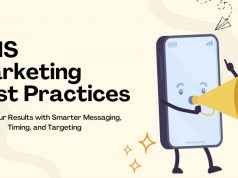In this digital age, SMS marketing has become one of the most efficient and effective ways to connect and engage with our customers. With over 90% open rates and response rates well outpacing email marketing, text message campaigns are a unique way for businesses to engage with their customers. This complete guide will teach you all you need to know about setting up SMS marketing for success.
Understanding SMS Marketing Fundamentals
SMS marketing is the practice of sending offers or notifications directly to customers’ mobile phones. Unlike emailing, which can be missed in crowded inboxes, texts show up directly on the recipients’ screen, almost impossible to ignore.
The beauty of SMS marketing is its straightforwardness and directness! When a customer gets a text, the customer generally reads it within minutes. This immediate connection allows for special promotions, emergent messages, and tailored customer messaging.
Contemporary SMS marketing solutions are connected to your business environment and can start sending out messages automatically and provide you with various customer segmentation and detailed analysis. That said, such tools can turn plain text messaging into a powerful marketing platform that can lead to sales, increased customer loyalty and better overall business communication.
Legal Requirements and Compliance
Organizations should be aware of any spam regulations before initiating any SMS marketing campaign. The Telephone Consumer Protection Act (TCPA) in America demands that recipients have provided their specific consent to receive promotional texts.
Consent is explicitly provided: customers must take action to sign up for messages, such as through web forms, keyword campaigns, point-of-sale enrollment. Companies are not allowed to buy lists of phone numbers or spam people en-mass.
All SMS marketing communication must contain the senders details and unsubscribe ability, ADDITIONAL TERMS These T&Cs are intended for use by a single user only. Typical compliance mechanisms include close of messages with “Reply STOP to un-subscribe.”
Businesses operating globally also need to take account of other privacy laws in jurisdictions such as Europe’s GDPR. Good records of consent and offering ease of data access or deletion contributes to ongoing compliance.
Picking the Best SMS Marketing Platform
Choosing an ideal SMS marketing platform is the backbone to your success. Key players such as Twilio, Klaviyo, and TextMagic feature contrasting functionality, pricing, and integration application.
When you’re looking at platforms, think about the size of your business, number of messages you’ll be sending, and technical capabilities. A small business may want easy on-boarding and predesigned templates, while a large enterprise may need APIs and advanced custom development options.
Consider features such as contact management, automated campaign workflows, personalization, analytics reporting, and the quality of service provided. Most platforms have free trials, or at least starter plans, for users to try out before they subscribe.
The ability to integrate with current business applications, such as CRM systems, e-commerce sites and e-mail marketing solutions, can also provide a boost to campaign performance. Select those that seamlessly integrate with your existing technology stack.
Building Your SMS Subscriber List
Building a high value subscriber list never happens by accident and it takes several contacts. Begin by finding natural touchpoints in which customers would be interested in text updates — order confirmations, appointment reminders, exclusive offers, etc.
List Building List building takes off through website integration. Embed SMS opt-in forms on popular pages, during checkouts, or on a content download. Provide good reasons to sign up on your promotional brochure – think discount codes, early access to sales, exclusive content etc.
When you fine-tune you do social media campaigns, you can accelerate your subscriber growth. Write engaging posts that focus on the value proposition of joining your SMS list and leverage platform-specific features such as Instagram Stories or Facebook lead ads to collect phone numbers.
There are valuable opportunities to build your SMS list with in-store experiences. Teach frontline staff to bring up SMS programs in customer interactions and offer QR codes or text-to-join campaigns that customers can turn on right away.
Creating Compelling SMS Content
Here at Broadnet, we have compiled a list of five tips for crafting text marketing messages that are both effective and successful through the means of SMS. With standard messages limited to 160 characters, each word forms part of the message that must justify itself to maximize its impact.
Each message should have a strong up-front value proposition that quickly tells recipients about the benefit you are delivering. Whether it’s an announcement of a sale, news or exclusive access, start with what they care about most.
SMS Marketing performs much more better with a personal touch. Leverage customer names, purchase history, location data or behavior to craft personalized, targeted messages that resonate with individual recipients.
Try to add some clear calls-to-action directing them to perform desired actions. No matter whether it’s getting website visits, store visits or specific products sold, you have to make the next step clear and simple.
Timing and Frequency Best Practices
Timing matters Timing of message can make a big difference to the success of SMS marketing. Studies have found, for example, that messages sent between 10 AM and 8 PM tend to produce higher engagement rates, and that messages sent very late at night or very early in the morning might be seen as a nuisance by the recipient.
When planning the campaigns, think of your audience’s lifestyle and the time zone they are in. Retailers could do well with lunchtime deals; B2B firms might want messages during the workday.
Control of frequency eliminates subscriber fatigue and lowers opt out rates. Most businesses do well on 2-4 messages per month, but this does depend on industry, what the audience wants, and what your message value is.
Experiment with different times of the day and how often to send to find the best times that work for your subscriber list. Leverage data analytics to iterate timing strategies, and optimize overall campaign performance.

Automation and Workflow Setup
Automated SMS workflows reduce manual hours and maintain steady contact with the customer. Typical automation use cases include new subscriber welcome series, abandoned cart reminders, and post-purchase engagement.
Introductions keep new subscribers happy, and expectations in check.” 2. Add details of the frequency of the message and other value propositions like special offers, and how to handle subscription preferences.
Behavior triggers generate targeted messages based on your customers’ activity. Configure workflows for site visits, product views, order completions, or to engage with past messages.
Nurturing: You can also employ drip campaigns to build and improve your relationships with all different kinds of customers. These could be educational resources, products and services suggestions, or even incremental offers to build conversion to over time.
Measuring SMS Marketing Success
Monitor KPIs to determine campaign effectiveness and inform campaign improvement strategies. Open rates, click-through rates, conversion rates, and even subscriber growth are all key indicators of how campaigns are performing.
Revenue attribution can show SMS marketing’s effect on driving business outcomes. Keep track of sales from the SMS campaigns and calculate the return on the investment to justify the budget and drive future strategies.
Analysis of subscriber behavior will help to identify the preferences of how subscribers watch. Track opt out rates, reply times, interaction levels and more to gauge audience behavior and improve the response to your campaigns in the future.
By running A/B tests on various message pieces — subject lines, copy, CTAs, timing, content format, and more — you can gradually make performance improvements on the fly. Test single factors to discover the individual forces at play.

Integration with Other Marketing Channels
SMS (Short Message Service) marketing is most effective when utilized as a part of an integrated marketing campaign across a variety of mediums. Pair SMS campaigns with email broadcast, social media, and ad campaigns to deliver a unified multi-channel experience for customers.
Cross-channel Touchpoints help build momentum of key campaigns and extend reach. Promote SMS offers (exclusive availability aka: email and social media) to increase subscribers and engage with current subscribers.
Understanding the customer journey helps identify the best trigger points for SMS. Leverage SMS to fill in the gaps between other marketing channels and usher customers through the conversion funnel.
Synchronization of data between platforms guarantees messages integrity and avoids communication conflicts. Combine SMS platforms with CRM and marketing automation tools, to create a single customer profile.
Maximizing Your SMS Marketing Investment
A successful SMS marketing is not just set up – it requires careful planning, legal adherence and proper execution. The high open rates and instant delivery of SMS marketing is a great weapon in the arsenal of businesses looking for direct customer interaction.
“Begin by having clear deliverables and level set expectations.” Concentrate on ways to create real value for subscribers as opposed to just pushing out promotion messages. Good content and good manners maintain a long term subs relationship.
Track performance with a focus on data-driven insight and adapt tactics on the go. The success of SMS marketing is based on knowing your audience, sending relevant messages, and making changes to the campaign based on measurable results.
Keep in mind that SMS marketing is a form of supplementing other marketing channels not substituting them. Carefully consider how and why text messages might fit in as part of your larger marketing strategy to make the most of your messaging and deliver a consistent brand experience on every channel.
From setting up SMS marketing campaigns to mastering digital marketing analytics, leveraging the right tools and data is essential for driving effective and measurable results









